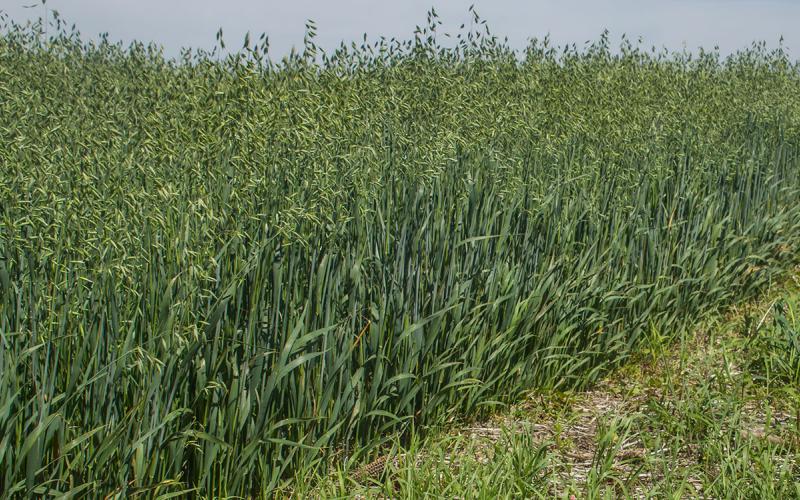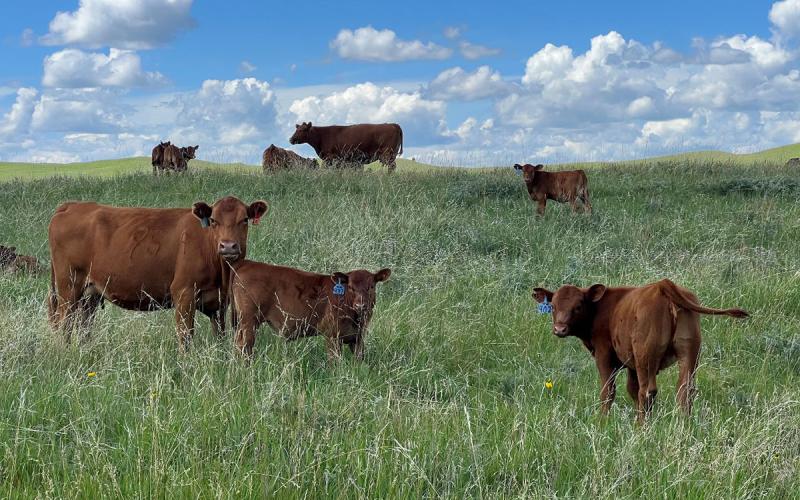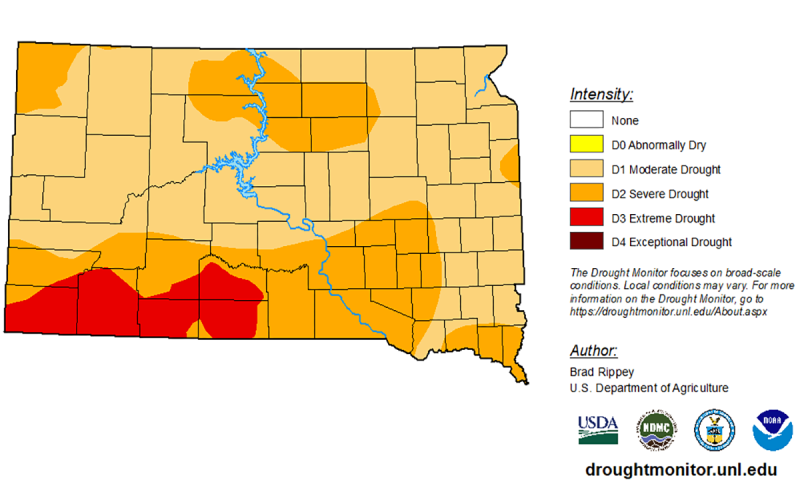
Much of South Dakota is currently under drought conditions again, as in recent years. Therefore, it is very important to use farming methods that reduce soil water evaporation and increase water infiltration and soil water retention. Under drought conditions, these methods can help to optimize crop yields and provide adequate forage for livestock. Management practices that can help to do this include no-till or reduced tillage; keeping crop residues in the field and on the soil surface (soil armor); having a rotational grazing system; planting multiple crops in rotation; and applying organic amendments to the soil, such as manures, composts and biochar. Applying many of the soil health principles to your operation, including minimizing disturbance, keeping the soil covered, having multiple crops growing, and incorporating livestock (manure additions), can help to improve soil health indicators, including water retention and infiltration. The current USDA Drought Monitor for South Dakota is shown in Figure 1.
Skip Tilling the Soil
Tilling the soil buries crop residue, destroys soil aggregates, and disrupts connected pores formed in the soil via soil organisms, old plant roots, and natural freeze/thaw and wet/dry cycles. Soils with medium to high clay contents form large cracks when very dry. Rainfall and snow melt can easily enter into these cracks and pores present and be stored in the plant rootzone. Tillage destroys these large cracks and pores and leads to reduced infiltration rate and water storage. Also, tilling the soil exposes dark soil to the surface. The dark soil absorbs more of the solar radiation from the sun and warms more than soil that is covered by lighter-colored crop residues. Warmer soils have greater water evaporation. Tilling the soil destroys soil aggregates and reduces soil organic matter content. Having greater soil organic matter content and a variety of aggregate sizes in the soil can increase water storage and infiltration compared to heavily tilled soil with mostly small aggregates (Blanco-Canqui and Ruis 2018).
Leave Crop Residue in the Field
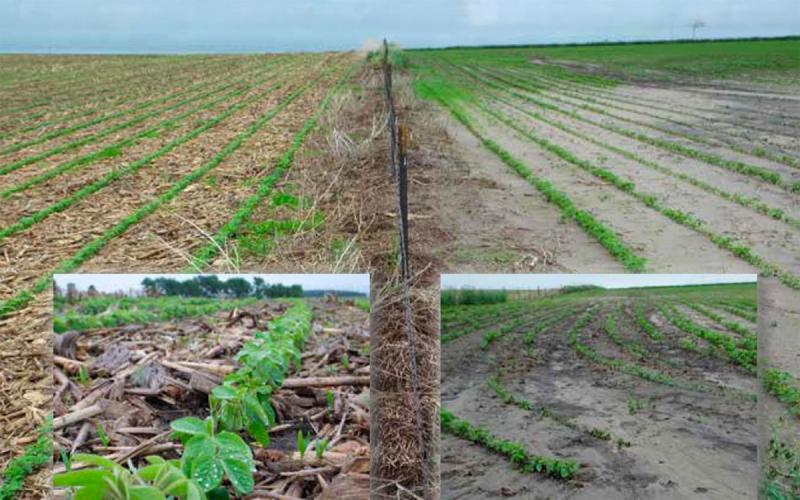
Removal of crop residues leads to similar negative impacts to soil health as tillage. Leaving crop residues on the soil surface provides armor and acts as an insulator on the soil surface. Crop residues are lighter in color compared to bare soil, which reduces the amount of solar radiation absorbed by the soil and keeps soil temperatures cooler compared to less residues covering soil surface. This leads to less evaporation of water occurring from the soil when there is adequate cover on the soil surface. Leaving crop residues in the field can increase soil organic matter, provide better habitat for soil organisms and improve soil properties, such as infiltration rate, aggregation, and water retention (Klopp and Blanco-Canqui 2022). Therefore, more of the water from limited precipitation during a drought enters the soil and is available to plants. When harvesting crops, the combine should be set so it spreads residues to cover the full width of the combine head so there are similar amounts of residue spread on the soil surface. An example of plots next to each other where corn residue is removed versus retained is shown in Figure 2.
Plant Cover Crops
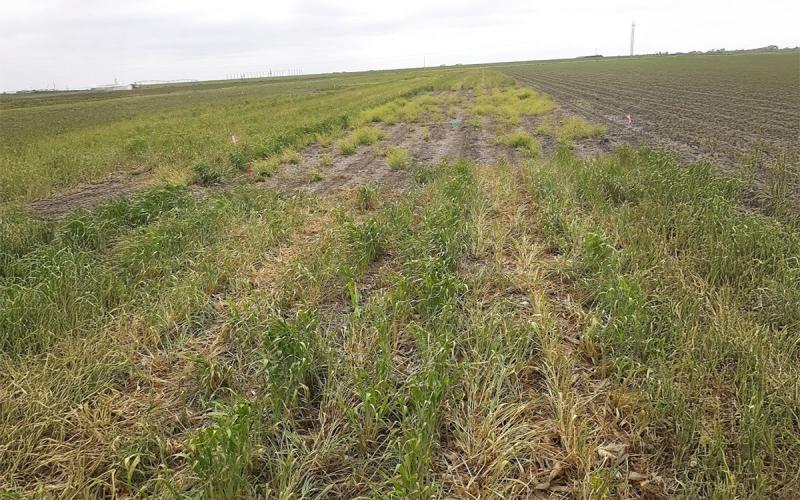
Cover cropping is a commonly used practice to improve soil health. Planting cover crops can have advantages and disadvantages during dry conditions. The major disadvantage of cover crops is they use soil water in addition to the main crops being grown. This may lead to reduced water availability for the crop planted following the cover crop. However, cover crops can lead to increased soil surface cover and improve soil health. The improvement in soil health from cover crops can lead to greater water infiltration and storage (Koudahe et al., 2022). More soil cover can reduce water evaporation due to less adsorption of heat and residue insulating the soil. An example of what a field looks like with and without cover crops is shown in Figure 3. Changing termination timing of the cover crop may be necessary to reduce water uptake and reduced available soil water for the following cash crop. Terminating overwintering cover crops 2 to 3 weeks prior to planting can lead to reduced uptake of water by the cover crop compared to planting green. However, this can lead to less cover present on the surface from the cover crop and improvements to soil health over the long term.
Have a Multiple Crop Rotation
Certain crops produce more residue, use more water, and require higher levels of water during different times of the year. Crop species, such as soybeans, peas, dry beans, canola, and camelina, produce low amounts of crop residue. Crops like corn, wheat, oats, rye, and sorghum produce higher amounts of crop residue. Planting a majority of crops in the rotation that produce higher amounts of residue can lead to greater cover on soil surface. Multiple crops in rotation can improve soil health indicators, such as organic matter content, water storage, and infiltration. Including crops with differing water requirements will lead to more crops succeeding and your cropping system being more resilient to adverse weather conditions. Crops, such as sorghum, sunflowers, and wheat, have lower water requirements than crops such as corn or soybeans.
Add Organic Amendments to the Soil
Soil organic matter is an essential material to create good soil structure. Soils with higher organic matter have greater pore space, water retention, aggregate stability, and infiltration rates. Adding organic materials to the soil, such as manures or compost, can help to increase soil organic matter content (Urra et al., 2019). This will allow there to be greater storage and infiltration of water in the soil. Organic materials can provide food for soil biology, which can further help to benefit soil health. This can include the method of grazing livestock on crop residues or cover crops. When grazing cover crops or grain crop residues in dry conditions, livestock should be removed when there is still adequate surface cover from crop residue or cover crops to ensure armor on soil surface. Having better soil health from organic amendment application can help to make soils and crops withstand dry climatic conditions better.
Use Methods to Improve Rangeland Soil Health
South Dakota’s rangelands can also benefit from improved management during droughts. Having better soil health in rangelands can improve their production, especially during drought conditions (Brown &Herrick 2016). One method to improve the health of rangelands is through prescribed grazing, such as rotational or multi paddock grazing (Teaugue & Krueter 2020). This will increase the number of plant species that are growing in the grassland. More plants will keep more cover on the surface. Over time these practices will lead to improved soil health of the grazing land soils and greater water infiltration and storage. Keeping cover on rangelands and having more species of plants growing also should increase their production under dry conditions. Only stock the rangelands based on the amount of forage that is available for them to graze. Overgrazing rangelands can lead to compaction issues and high amounts of bare soil. This can lead to a degradation of soil health and biology living in rangeland soils. Animals should be removed from rangeland pastures when there is still some cover present on the surface. Ensuring more cover on the soil surface can help to keep rangeland functioning good functioning in ever-changing weather conditions.
Summary
Dry conditions can create difficulties for agricultural producers. Using many of the soil health principles can improve the resilience of agricultural systems to dry conditions. Healthy soils have better water infiltration and storage compared to unhealthy soils, which makes the soil more resilient to dry conditions. Keeping an adequate level of cover on the soil surface also helps to reduce evaporation of water from the soil. Practices, such as minimizing disturbance, leaving cover on the surface, and having multiple species of plants growing, can help to optimize crop and forage production in dry conditions.
References
- Blanco-Canqui, H., & Ruis, S. J. (2018). No-tillage and soil physical environment. Geoderma, 326, 164-200.
- Brown, J. R., & Herrick, J. E. (2016). Making soil health a part of rangeland management. Journal of Soil and Water Conservation, 71(3), 55A-60A.
- Klopp, H. W., & Blanco‐Canqui, H. (2022). Implications of crop residue removal on soil physical properties: A review. Soil Science Society of America Journal, 86(4), 979-1001.
- Koudahe, K., Allen, S. C., & Djaman, K. (2022). Critical review of the impact of cover crops on soil properties. International Soil and Water Conservation Research, 10(3), 343-354.
- Teague, R., & Kreuter, U. (2020). Managing grazing to restore soil health, ecosystem function, and ecosystem services. Frontiers in Sustainable Food Systems, 4, 534187.
- Urra, J., Alkorta, I., & Garbisu, C. (2019). Potential benefits and risks for soil health derived from the use of organic amendments in agriculture. Agronomy, 9(9), 542.

